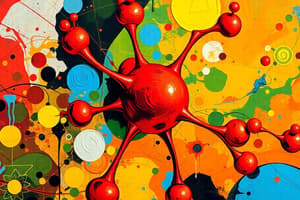Podcast
Questions and Answers
What is the primary role of antioxidants in the body?
What is the primary role of antioxidants in the body?
- To degrade proteins
- To promote free radical formation
- To increase the reactivity of cells
- To inhibit oxidative damage (correct)
Which statement accurately describes free radicals?
Which statement accurately describes free radicals?
- Highly reactive and unstable molecules (correct)
- Stable molecules that do not cause harm
- Molecules commonly found in healthy foods
- Substances that neutralize oxidative stress
What are common sources of antioxidants?
What are common sources of antioxidants?
- Artificial supplements only
- Fruits, vegetables, and nuts (correct)
- Heavy metals and toxins
- Processed foods and sugars
What effect do antioxidants have on aging?
What effect do antioxidants have on aging?
Which of the following statements about free radicals is correct?
Which of the following statements about free radicals is correct?
How do antioxidants interact with free radicals?
How do antioxidants interact with free radicals?
What is a misconception about antioxidants?
What is a misconception about antioxidants?
What is the primary role of NADPH-oxidase in leukocytes?
What is the primary role of NADPH-oxidase in leukocytes?
How do free radicals influence cellular signaling?
How do free radicals influence cellular signaling?
Which of the following describes the synergistic effect of antioxidants?
Which of the following describes the synergistic effect of antioxidants?
What is the primary physiological function of myeloperoxidase?
What is the primary physiological function of myeloperoxidase?
What does the term 'redox state' refer to?
What does the term 'redox state' refer to?
What is the effect of an imbalance between free radicals and antioxidants in the body?
What is the effect of an imbalance between free radicals and antioxidants in the body?
Which of the following is NOT a source of free radicals?
Which of the following is NOT a source of free radicals?
Which type of free radical is NOT listed as a reactive oxygen species?
Which type of free radical is NOT listed as a reactive oxygen species?
What contributes to oxidative stress in the body?
What contributes to oxidative stress in the body?
Which of the following represents an internal source of free radicals?
Which of the following represents an internal source of free radicals?
Which radical is characterized as a reactive oxygen species?
Which radical is characterized as a reactive oxygen species?
Which action can exacerbate oxidative stress in the body?
Which action can exacerbate oxidative stress in the body?
What role do antioxidants play in relation to free radicals?
What role do antioxidants play in relation to free radicals?
Which external factor is a significant contributor to free radical production?
Which external factor is a significant contributor to free radical production?
Which process in the mitochondria is primarily responsible for the production of superoxide?
Which process in the mitochondria is primarily responsible for the production of superoxide?
What role does cytochrome P-450 play in free radical generation?
What role does cytochrome P-450 play in free radical generation?
How do antioxidants prevent damage from free radicals?
How do antioxidants prevent damage from free radicals?
What is a primary source of free radicals from leukocytes?
What is a primary source of free radicals from leukocytes?
What does oxidative stress result from?
What does oxidative stress result from?
What happens during the oxidation of hemoglobin to methemoglobin?
What happens during the oxidation of hemoglobin to methemoglobin?
What is the effect of antioxidants on the chain reaction caused by free radicals?
What is the effect of antioxidants on the chain reaction caused by free radicals?
What percentage of oxygen generally enters the respiratory chain through complexes I and III?
What percentage of oxygen generally enters the respiratory chain through complexes I and III?
Which molecules do free radicals primarily target for electron stealing?
Which molecules do free radicals primarily target for electron stealing?
Which type of antioxidant is specifically produced by the body?
Which type of antioxidant is specifically produced by the body?
What is the role of Superoxide Dismutase (SOD)?
What is the role of Superoxide Dismutase (SOD)?
Which vitamin is known for protecting cell membranes from lipid peroxidation?
Which vitamin is known for protecting cell membranes from lipid peroxidation?
Which of the following is an example of a non-enzymatic antioxidant?
Which of the following is an example of a non-enzymatic antioxidant?
Which mineral is a cofactor for antioxidant enzymes like glutathione peroxidase?
Which mineral is a cofactor for antioxidant enzymes like glutathione peroxidase?
Flavonoids, known for combating oxidative stress, are primarily found in which food source?
Flavonoids, known for combating oxidative stress, are primarily found in which food source?
Which of the following antioxidants is found outside of membranes?
Which of the following antioxidants is found outside of membranes?
Which antioxidant is known as a master antioxidant due to its ability to regenerate other antioxidants?
Which antioxidant is known as a master antioxidant due to its ability to regenerate other antioxidants?
Carotenoids such as beta-carotene provide protection against which type of damage?
Carotenoids such as beta-carotene provide protection against which type of damage?
Which enzymatic antioxidant breaks down hydrogen peroxide into water and oxygen?
Which enzymatic antioxidant breaks down hydrogen peroxide into water and oxygen?
Flashcards
What are antioxidants?
What are antioxidants?
Substances that protect cells, proteins, and DNA from damage caused by highly reactive molecules called free radicals.
What are free radicals?
What are free radicals?
Highly reactive molecules with an unpaired electron, making them unstable and prone to damaging cells through oxidation.
What is oxidation?
What is oxidation?
The process of losing electrons, which can lead to the formation of free radicals and damage to cells, proteins, and DNA.
What is oxidative stress?
What is oxidative stress?
Signup and view all the flashcards
How do antioxidants work?
How do antioxidants work?
Signup and view all the flashcards
Where do we get antioxidants?
Where do we get antioxidants?
Signup and view all the flashcards
What are the benefits of antioxidants?
What are the benefits of antioxidants?
Signup and view all the flashcards
Free Radicals
Free Radicals
Signup and view all the flashcards
Oxidative Stress
Oxidative Stress
Signup and view all the flashcards
Cellular Metabolism
Cellular Metabolism
Signup and view all the flashcards
Inflammation
Inflammation
Signup and view all the flashcards
Enzymatic Reactions
Enzymatic Reactions
Signup and view all the flashcards
Pollution
Pollution
Signup and view all the flashcards
Radiation
Radiation
Signup and view all the flashcards
Smoking
Smoking
Signup and view all the flashcards
Chemical Exposure
Chemical Exposure
Signup and view all the flashcards
What are endogenous antioxidants?
What are endogenous antioxidants?
Signup and view all the flashcards
What are exogenous antioxidants?
What are exogenous antioxidants?
Signup and view all the flashcards
What does Superoxide Dismutase (SOD) do?
What does Superoxide Dismutase (SOD) do?
Signup and view all the flashcards
What does Catalase do?
What does Catalase do?
Signup and view all the flashcards
What is the role of Glutathione Peroxidase?
What is the role of Glutathione Peroxidase?
Signup and view all the flashcards
What is Glutathione?
What is Glutathione?
Signup and view all the flashcards
What is Coenzyme Q10?
What is Coenzyme Q10?
Signup and view all the flashcards
Where is Cytochrome c located?
Where is Cytochrome c located?
Signup and view all the flashcards
What does Vitamin C do?
What does Vitamin C do?
Signup and view all the flashcards
How does Vitamin E protect cells?
How does Vitamin E protect cells?
Signup and view all the flashcards
What is a free radical?
What is a free radical?
Signup and view all the flashcards
What are monooxygenases?
What are monooxygenases?
Signup and view all the flashcards
How do antioxidants work together?
How do antioxidants work together?
Signup and view all the flashcards
Exogenous Antioxidants
Exogenous Antioxidants
Signup and view all the flashcards
Membrane Enzymes with Flavin Structures
Membrane Enzymes with Flavin Structures
Signup and view all the flashcards
Hem Coenzymes
Hem Coenzymes
Signup and view all the flashcards
Enzymes containing a copper atom
Enzymes containing a copper atom
Signup and view all the flashcards
Respiratory Chain in Mitochondria
Respiratory Chain in Mitochondria
Signup and view all the flashcards
Endoplasmic Reticulum
Endoplasmic Reticulum
Signup and view all the flashcards
Special Cells (Leukocytes)
Special Cells (Leukocytes)
Signup and view all the flashcards
Hemoglobin to Methemoglobin Oxidation
Hemoglobin to Methemoglobin Oxidation
Signup and view all the flashcards
Donation of Electrons
Donation of Electrons
Signup and view all the flashcards
Breaking the Chain Reaction
Breaking the Chain Reaction
Signup and view all the flashcards
Study Notes
Advanced Medical Biochemistry - Lecture 6: Antioxidants
- Antioxidants are substances that inhibit or neutralize oxidative damage caused by free radicals. These protect cells, proteins, and DNA from harm.
- Free radicals are unstable molecules with unpaired electrons, making them highly reactive and capable of damaging cells via oxidation.
- Oxidative stress occurs when the body produces more free radicals than it can neutralize with antioxidants. This imbalance can lead to cellular damage and contribute to various diseases and aging processes.
Different between Free radical and Antioxidants
- Definition: Antioxidants prevents/reduces damage caused by oxidation; Free radicals are highly reactive molecules that damage cells via oxidation
- Nature: Antioxidants are stable; Free radicals are highly unstable.
- Role in the Body: Antioxidants protects cells by neutralizing free radicals; Free radicals cause oxidative stress leading to cell damage.
- Source: Antioxidants are found in healthy foods, fruits, vegetables, and nuts; Free radicals are formed naturally in the body or by external factors like pollution or smoking.
- Effect: Antioxidants prevent aging and chronic diseases; Free radicals contribute to aging and increase the risk of diseases.
Antioxidants vs. Free radical
- Free radicals are unstable molecules with unpaired electrons. Antioxidants are stable molecules.
Importance of Antioxidants
- Cellular Protection: Antioxidants neutralize harmful free radicals protecting DNA, proteins, and lipids.
- Oxidative Stress Reduction: Maintaining a balance between free radicals and antioxidants reduces risk of chronic conditions.
- Disease Prevention: Antioxidant intake can decrease risks of heart disease, cancer, neurodegenerative disorders, and boost immune function.
- Anti-Aging Benefits: Antioxidants prevent damage from UV exposure and premature aging.
- Health Maintenance: Antioxidants support proper cellular integrity and organ/tissue function.
Brief History: Discovery and Relevance in Health and Science
- Early 20th Century: Free radicals were identified as highly reactive molecules in chemical reactions.
- 1954: Dr. Denham Harman proposed the Free Radical Theory of Aging, linking free radicals to cellular damage and aging.
- 1960s: Discovery of free radicals' role in diseases like cancer, diabetes, and cardiovascular disorders. Antioxidants were identified as protective agents against oxidative stress.
- Present Day: Free radicals are central to research in health, aging, and chronic diseases. Their role in environmental damage and industrial applications is widely studied.
Free Radicals and Oxidative Stress
- Definition: Free radicals are unstable molecules with unpaired electrons making them highly reactive. Oxidation is the process where atoms lose electrons.
- Oxidative Stress: Imbalance between free radical production and the body's antioxidant capacity. Oxidative stress causes cellular damage contributing to diseases and aging.
Sources of Free Radicals
- Internal Sources: Cellular metabolism (byproducts of energy production in mitochondria), inflammation (immune response generates reactive oxygen species), and enzymatic reactions (natural biochemical processes).
- External Sources: Pollution, ultraviolet radiation, radiation, smoking, industrial/chemical exposures, and pesticides.
ROS (Reactive Oxygen Species)
- Divided into two categories: free radicals (superoxide, hydroxyl radical, peroxyl, alkoxyl, and hydroperoxyl) and particles that are not free radicals (hydrogen peroxide, hypochlorous acid, ozone, and singlet oxygen).
Impact of Oxidative Stress
- Cell damage
- Accelerated aging
- Chronic diseases (cancer, cardiovascular disease)
Oxidative Stress: Mechanism and Consequences
- Oxidative stress occurs when the production of free radicals exceeds the body's ability to neutralize them.
- Free radicals damage DNA, proteins, and lipids and disrupt normal cellular functions.
- DNA damage can lead to mutations, increasing the risk of cancer.
- Alters protein structure and function, impacting enzyme and cellular signaling.
- Free radicals attack lipids in cell membranes causing cell death and compromising cell integrity.
- Contributes to aging, and chronic diseases (cardiovascular disease, diabetes, and neurodegenerative disorders like Alzheimer's).
Types of Antioxidants
- Endogenous: Produced by the body.
- Enzymatic: Superoxide dismutase (SOD), catalase, and glutathione peroxidase.
- Non-enzymatic: Glutathione, Coenzyme Q10.
- Exogenous: Obtained from diet.
- Vitamins: Vitamin C, Vitamin E,
- Minerals: Selenium, Zinc.
- Phytochemicals: Flavonoids, carotenoids, and polyphenols.
Exogenous Antioxidants
- Drugs and compounds that influence free radical metabolism.
- Pharmaceutical and dietary compounds that modulate free radical activity and oxidative stress.
The Main Sources of Free Radicals
- Respiratory Chain in Mitochondria: Produces superoxide and hydrogen peroxide.
- Endoplasmic Reticulum: Generates superoxide through cytochrome P-450 enzymes.
- Special Cells (Leukocytes): Produce superoxide using NADPH-oxidase as part of their immune defense mechanism.
- Hemoglobin to Methemoglobin Oxidation: Oxidation of hemoglobin generates radicals. Erythrocytes are full of antioxidants to counteract this.
Mechanism of Action: How Antioxidants Work
- Electron Donation: Antioxidants donate electrons to neutralize free radicals, stabilizing them without becoming reactive.
- Breaking the Chain Reaction: Free radicals cause a chain reaction of oxidative damage by stealing electrons. Antioxidants interrupt this process, stopping further cellular damage.
Free Radicals Physiological Function
- Usage in processes involving oxides and oxygen molecules
- Cytochromoxidase: Produces toxic intermediates (H2O2, superoxide).
- Monooxygenases: Activate O2 in the liver or adrenal gland mitochondria, involved in hydroxylation.
- NADPH-oxidase: Found in leukocytes, generates superoxide (antimicrobial function).
- Myeloperoxidase: Catalyzes H2O2 + Cl+H+→ HClO + H2O (potent antimicrobial HClO)
Free Radicals Physiological Function (Signal Molecules, Redox State)
- Signal Molecules: Free radicals act as intermediates in cellular signaling.
- Redox State: Balances antioxidant capacity, reduction equivalent availability, and ROS and RNS production. ROS often act as second messengers in signal transduction.
Mechanism of Action: How Antioxidants Work (Synergistic Effects)
- Different antioxidants work together to enhance protection. For example, vitamin C regenerates vitamin E.
- Enzymatic and nonenzymatic support each other to maximize defense.
- This synergy provides comprehensive protection against oxidative stress.
Sources of Antioxidants
- Dietary: Fruits, vegetables, beverages like green tea and coffee.
- Supplementation: Convenient way to boost levels, though there are caveats.
Health Benefits of Antioxidants
- Reduce risk of chronic diseases (cardiovascular, cancer, neurodegenerative).
- Promote skin health, and reduce oxidative damage.
- Boost immune health and support immune response.
Role of Antioxidants in Immune Health
- Neutralizing free radicals protecting immune cells and cell membranes.
- Reducing inflammation and enhancing immune response.
- Boosting immune cells (lymphocytes and macrophages).
- Supporting skin barrier immunity.
- Preventing chronic diseases linked to weakened immunity.
Enzymes Defence Mechanism
- Enzymes like Superoxide dismutase (SOD) and catalyse break down hydrogen peroxide and reactive oxygen species.
- Glutathione cycle depicted is crucial in maintaining cellular defenses by regenerating antioxidants.
Assignment (3): Free radicals and antioxidants
- Definition of Free radical and reactive oxygen species (ROS) and nitrogen species (RNS).
- Are RNS and ROS always dangerous?
- Definition and significance of oxidative stress
- Types and characteristics of antioxidants.
- Markers of oxidative stress.
- Diseases associated with oxidative stress.
Studying That Suits You
Use AI to generate personalized quizzes and flashcards to suit your learning preferences.
Related Documents
Description
Test your knowledge on the roles of antioxidants and free radicals in the body. This quiz covers their functions, sources, and effects on aging and cellular signaling. Perfect for understanding the importance of redox state in physiology!




